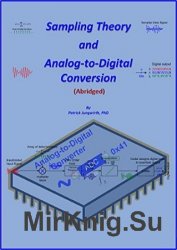Sampling Theory and Analog-to-Digital Conversion (Abridged)
- Добавил: M5662
- Дата: 26-01-2017, 17:27
- Комментариев: 1

Название: Sampling Theory and Analog-to-Digital Conversion (Abridged)
Автор: Patrick Jungwirth
Издательство: Independently published
Год: 2016
Страниц: 204
Формат: DJVU, PDF (True)
Размер: 14 Мб
Язык: English
This is an abridged edition of "Sampling Theory and Analog-to-Digital Conversion".
Why another book on sampling theory and analog-to-digital conversion? This book takes a linear system theory approach to analog-to-digital conversion. From linear systems theory, we introduce sampling theory and use the tools from linear system theory to prove Shannon's sampling theorem. Shannon's sampling theorem shows how an analog signal can be converted to a discrete time signal and how the original can be exactly recovered from the discrete time signal. Digital is an approximation to discrete time so exact reconstruction is not possible; however, practically speaking the reconstructed signal is identical to the original analog signal. Digital is more than just 1's and 0's. Digital technology is universal. Once data is in digital form, it can be converted from one digital format to another without any additional loss of information (excluding lossy data compression).
We use linear system theory and the sampling theorem to derive the model for an ideal analog to digital converter. We derive performance metrics from the ideal model. The performance metrics are put to good use to illustrate how to test and evaluate an analog-to-digital converter. Applications motivate the reader to apply concepts learned. More complex applications lead the reader to an introduction to software defined radios. Appendices provide summaries of the sampling theorem, communications engineering units, transform tables, and ADC model.
Chapter 1 begins by introducing the digital world. Money is used to introduce analog, discrete, and digital. Chapter 2 starts off with a simple description of linear systems. Chapter 2 takes the reader from algebra, calculus, differential equations, Fourier transforms, and back to algebra. We want the reader to have a basic understanding of signal processing. Linear system theory provides the tools to prove the sampling theorem in Chapter 3. A graphical proof and analytical proof of the sampling theorem are presented in Chapter 4. We show why wagon wheels turn backwards in Western movies.
Chapter 5 covers the binary math, we need to work with analog-to-digital converters. Code examples are provided for the "software interface" for an analog-to-digital converter. A useful part of Chapter 5 is how to solve the problem of a signed 10 bit analog-to-digital converter connected to a 16 bit microprocessor. (not included in abridged edition).
The ideal analog-to-digital converter model is developed in Chapter 6. Chapter 7 introduces some common analog-to-digital converters: flash, pipeline, successive approximation register, and delta sigma (I”I?). Performance metrics and testing of analog-to-digital converters are found in Chapter 8. Chapter 9 presents sampling and analog-to-digital conversion applications. Chapter 10 covers a brief introduction to analog-to-digital converter datasheets focused on software defined radio applications. (not included in abridged edition).
Chapter 11 presents an introduction to radio receiver block diagrams and finishes with a short introduction to software defined radios. Chapter 11 completes the journey from linear systems, to sampling theory, to analog-to-digital converters, and then the most useful part, applications. We hope this book serves as a good stepping stone to more complex applications. As computer power continues to increase and costs continue to drop, new applications will be found for the future. Be part of developing the future. If you have any suggestions for improvements, or find errors please email the book author (see book preface).
Скачать Jungwirth P. - Sampling Theory and Analog-to-Digital Conversion (Abridged)
[related-news] [/related-news]
Внимание
Уважаемый посетитель, Вы зашли на сайт как незарегистрированный пользователь.
Мы рекомендуем Вам зарегистрироваться либо войти на сайт под своим именем.
Уважаемый посетитель, Вы зашли на сайт как незарегистрированный пользователь.
Мы рекомендуем Вам зарегистрироваться либо войти на сайт под своим именем.

Комментарии пользователей